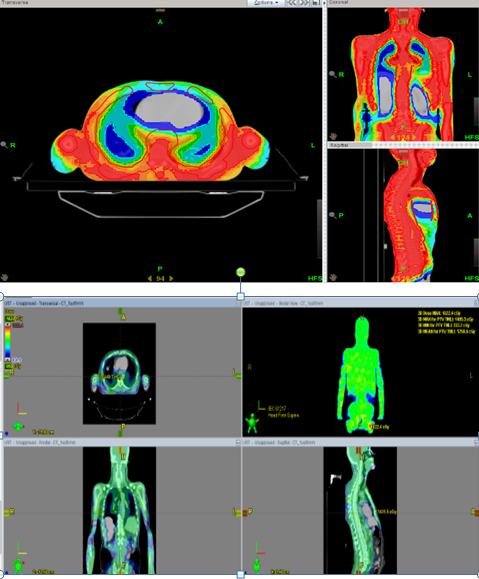Total Marrow and Lymphoid Irradiation via Arc IMRT and Helical Tomotherapy
PO-1671
Abstract
Total Marrow and Lymphoid Irradiation via Arc IMRT and Helical Tomotherapy
Authors: Gizem Kavak Eren1, Ferihan Ertan2, Serdar Şahin1, Ebru Atasever Akkas1, Ebru Karakaya1
1Dr. Abdurrahman Yurtaslan Ankara Oncology Hospital, Radiation Oncology, Ankara, Turkey; 2Dr. Abdurrahman Yurtaslan Ankara Oncology Hospital, Radiation oncology, Ankara, Turkey
Show Affiliations
Hide Affiliations
Purpose or Objective
Total body irradiation (TBI) is a radiotherapy technique that has been used for over a century in various benign and malignant diseases. Opposed lateral irradiation technic via linear accelerator is applied to patients who will be using TBI in the hematological stem cell transplantation preparation regimen in our clinic. This TBI technique often results in high dose heterogeneity in patients and also does not preserve OARs other than the lungs. So the toxicity of treatment especially in combination with chemotherapy is high. The concepts of Total marrow irradiation (TMI) and Total marrow and lymphoid irradiation (TMLI) come into play in order to challenge this situation. It is known that with TMI/TMLI methods, the target tissue and organs at risk (OARs) are contoured and it is possible to protect more effectively OARs while giving more homogeneous doses to target volumes. Our aim in this study is TMLI planning via Arc IMRT and Helical Tomotherapy methods as an alternative to the old conventional techniques, also to compare these two planning techniques.
Material and Methods
Two CTs were taken with 5 mm cross-section intervals, phased upper and lower, in 7 patients with ALL. The patients were fixed with a C pillow, thermoplastic head-neck mask and vacuum bed. After the upper CT, the lower CT was taken by turning the coach board without getting up the patient. Whole body bones (excluding mandible, hands and feet), all lymphoid structures (head and neck, waldeyer lymphatic ring, axilla, mediastinum, abdomen, pelvic lymphatics), brain, scrotum and spleen were targeted as PTV. Critical structures in the whole body were also delineated. The mean contouring time for one patient was 5.5 hours. Arc IMRT and Helical Tomotherapy planning were performed for each patient (In the attached picture, a section from both physics plans is shown). Arc IMRT plannings were done 4 isocenters for the upper body. Helical Tomotherapy planning parameters were taken as pitch factor 0,397, modulation factor 2-2,3, field width 5 cm.

Picture 1: Helical Tomotherapy plan dose distribution(upper) and Arc IMRT plan dose distribution(lower)
Results
The results of the physics plans of 7 patients are summarized in the table in the attached picture. Wilcoxon tests were performed for statistical analysis.

Table 1: PTVs and OARs doses for Arc IMRT and Helical Tomotherapy plans
Conclusion
TMLI plannings were made us capable of giving more homogeneous doses target volumes while reducing the dose to OARs much more effectively than conventional methods. Two TMLI methods by means of Arc IMRT and Helical Tomotherapy were successful, although OAR doses were statistically lowered with Helical Tomotherapy plans. Contouring and planning times were quite long but they could be decreased in the future. As a result, TMLI technique can change our routine practice, maybe other cliniques who uses conventional techniques for TBI.